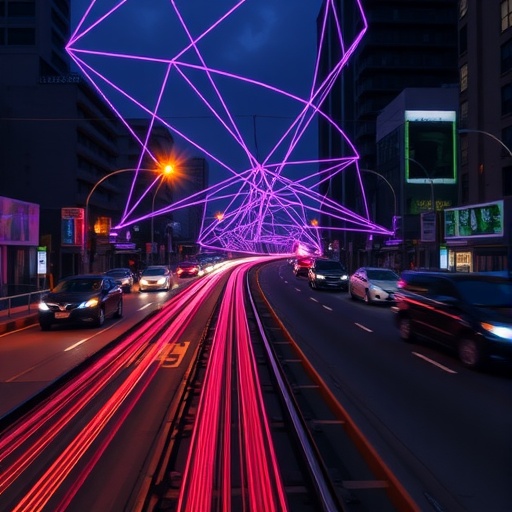In the ever-evolving world of urban mobility, the quest for efficient and sustainable transit systems has reached a pivotal moment. Research conducted by Gamal and Ibrahim, as published in the journal Discover Cities, sheds light on the revolutionary potential of graph neural networks (GNNs) for optimizing real-time operations within autonomous urban transit systems. This intersection of advanced artificial intelligence with public transportation could not only enhance efficiency but could also redefine the way cities approach transit logistics.
An autonomous urban transit system represents a significant leap forward in urban mobility. These systems promise to alleviate traffic congestion, reduce carbon emissions, and enhance accessibility for all citizens. However, realizing this potential requires sophisticated technology that can analyze and manage vast amounts of real-time data. This is where graph neural networks come into play, providing a framework that can learn and predict transit behavior patterns in a way that traditional methods simply cannot achieve.
At the core of GNNs is their ability to model relationships between entities in a graph-like structure. In the context of urban transit, this means viewing transit routes, bus stops, and user behaviors as nodes and edges within a graph. By utilizing this approach, GNNs can develop a deeper understanding of the complex interactions present in urban transit systems. This allows for more accurate predictions regarding transit demand, traffic flow, and route optimization.
In their rigorous study, Gamal and Ibrahim investigate the implementation of GNNs to analyze and optimize various aspects of autonomous transit systems. They report that using GNNs for real-time data processing and decision-making significantly improves operational efficiency. With the ability to adjust routes and schedules dynamically based on current demand, these advanced models are instrumental in minimizing wait times and maximizing service reliability for commuters.
Moreover, the application of GNNs allows for more granular insights into user behavior. By aggregating data from multiple sources, including mobile apps and sensors, these systems can determine which routes are most popular at various times of the day, enabling more responsive service provision. This adaptability is crucial for maintaining a high level of customer satisfaction and ensuring that the transit network remains relevant in a rapidly changing urban landscape.
One of the most exciting implications of this research is its potential to contribute to sustainable urban development. The traditional automotive-centric approach has led to significant environmental concerns, such as increasing emissions and urban sprawl. Autonomous transit systems powered by GNNs offer an Eco-friendlier alternative by optimizing routes and reducing unnecessary travel. This can lead to a considerable decrease in the number of vehicles on the road, thereby reducing traffic congestion and cutting down on greenhouse gas emissions.
Furthermore, GNNs are not just beneficial for optimizing routes—they also play a vital role in ensuring safety and reliability. By constantly analyzing data from various inputs, these networks can identify abnormal patterns indicative of potential issues, such as accidents or delays. This proactive approach enables transit authorities to respond promptly, improving overall safety and minimizing service disruptions.
In their findings, Gamal and Ibrahim highlight the critical role of simulation in their research. They utilized simulation environments to validate the performance of GNNs compared to traditional algorithmic approaches. Their results exhibited a marked improvement in efficiency, illustrating the potential for GNNs to set a new standard in urban transit optimization.
However, the integration of such technology does not come without challenges. For instance, the scalability of GNNs in large metropolitan areas poses a significant hurdle. Researchers must consider the computational intensity of these models and the vast amount of data generated by urban transit networks. Addressing these challenges will require collaborative efforts between technologists, urban planners, and policymakers to ensure that the advantages of GNNs are effectively harnessed.
As cities worldwide strive to develop smarter transit solutions, the insights provided by this research are invaluable. The study by Gamal and Ibrahim opens up new avenues for further exploration and development in the realm of autonomous transit systems. Ensuring that cities can adapt to the needs of their populations while minimizing environmental impact is an urgent priority, and innovations such as GNNs represent significant progress toward achieving these goals.
In conclusion, the exploration of graph neural networks in optimizing autonomous urban transit systems marks a transformative step in urban mobility. The implications of this research extend far beyond improved efficiency and reliability; they touch on the very essence of sustainable urban living. As the world grapples with urbanization challenges, the integration of advanced AI technologies like GNNs could pave the way for a future where transit systems contribute positively to urban ecosystems.
In summary, the research conducted by Gamal and Ibrahim is not just a technical advancement; it is a glimpse into the future of urban transit systems, one that prioritizes the needs of citizens and the health of our planet. As we move forward, the lessons learned from this research will be essential in shaping the cities of tomorrow.
Subject of Research: Optimization of autonomous urban transit systems using graph neural networks
Article Title: Graph neural networks for real-time optimization of autonomous urban transit systems
Article References:
Gamal, M., Ibrahim, O.A. Graph neural networks for real-time optimization of autonomous urban transit systems.
Discov Cities 2, 102 (2025). https://doi.org/10.1007/s44327-025-00145-4
Image Credits: AI Generated
DOI: https://doi.org/10.1007/s44327-025-00145-4
Keywords: Graph neural networks, urban transit systems, optimization, autonomous transit, sustainability, real-time data, AI in transportation, smart cities.




